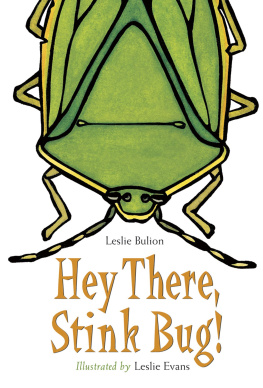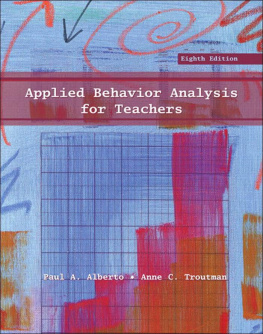Leslie Julian C. - Behavior Analysis
Here you can read online Leslie Julian C. - Behavior Analysis full text of the book (entire story) in english for free. Download pdf and epub, get meaning, cover and reviews about this ebook. year: 2016, publisher: Taylor & Francis Group, genre: Romance novel. Description of the work, (preface) as well as reviews are available. Best literature library LitArk.com created for fans of good reading and offers a wide selection of genres:
Romance novel
Science fiction
Adventure
Detective
Science
History
Home and family
Prose
Art
Politics
Computer
Non-fiction
Religion
Business
Children
Humor
Choose a favorite category and find really read worthwhile books. Enjoy immersion in the world of imagination, feel the emotions of the characters or learn something new for yourself, make an fascinating discovery.
- Book:Behavior Analysis
- Author:
- Publisher:Taylor & Francis Group
- Genre:
- Year:2016
- Rating:3 / 5
- Favourites:Add to favourites
- Your mark:
- 60
- 1
- 2
- 3
- 4
- 5
Behavior Analysis: summary, description and annotation
We offer to read an annotation, description, summary or preface (depends on what the author of the book "Behavior Analysis" wrote himself). If you haven't found the necessary information about the book — write in the comments, we will try to find it.
Behavior Analysis — read online for free the complete book (whole text) full work
Below is the text of the book, divided by pages. System saving the place of the last page read, allows you to conveniently read the book "Behavior Analysis" online for free, without having to search again every time where you left off. Put a bookmark, and you can go to the page where you finished reading at any time.
Font size:
Interval:
Bookmark:

Behavior Analysis
Foundations and Applications to Psychology
Julian C. Leslie
University of Ulster, Northern Ireland
and
Mark F. OReilly
University College Dublin, Ireland

First published 1999 by Harwood Academic Publishers
Amsteldijk 166, 1st Floor, 1079 LH Amsterdam, The Netherlands
Reprinted 2003
by Psychology Press
27 Church Road, Hove, East Sussex BN3 2FA
711 Third Avenue, New York, NY 10017
Psychology Press is a part of the Taylor & Francis Group, an Informa business
Copyright 1999 OPA (Overseas Publishers Association) NV.
Published by license under Psychology Press
Transferred to Digital Printing 2003
All rights reserved. No part of this book may be reprinted or reproduced or utilized in any form or by any electronic, mechanical, or other means, now known or hereafter invented, including photocopying and recording, or in any information storage or retrieval system, without permission in writing from the publishers.
British Library Cataloguing in Publication Data
A catalogue record for this book is available from the British Library
ISBN: 978-90-5702-486-3 (pbk)
Publishers Note
The publisher has gone to great lengths to ensure the quality of this reprint but points out that some imperfections in the original may be apparent.
" |
| Matching extinction protocol to maintaining contingencies |
| Descartes' model of how an external event might cause bodily movement. |
| A typical arrangement for studying salivation in a conditioning experiment in Pavlov's 19th century laboratory. |
| Essential features of a Skinner box for a rat, or other small rodent. |
| Event records, or "time lines", illustrating a contingency between, or independence of, Event A and Event B. |
| A cumulative recorder of a type that was used extensively until replaced by computer software systems. |
| Cumulative records obtained frofn four rats on their first session of operant conditioning. |
| Relative frequencies of several behaviors occurring in a Skinner box before and after operant conditioning of lever pressing. |
| Distribution of response forces when (A, upper graph) all responses with a force of more than 21 g were reinforced, and (B, lower graph) when all responses with a force of more than 36 g were reinforced. |
| Cumulative record of responding in extinction of lever press response previously reinforced with food. |
| Cumulative records of lever pressing for two rats reinforced with food 100 times and then transferred to a response independent food presentation schedule. |
| Apparatus used by Antonitis (1951) to reinforce nose poking. |
| Apparatus used for measuring aggression induced by extinction in a Skinner box. |
| Resistance to extinction of lever pressing as a function of the weight of the lever (or bar). |
| Spontaneous recovery from extinction of a rat's lever-press response. |
| Averaged cumulative response curves for the first (1), fifth (5), and tenth (10) sessions of extinction. |
| Average data for classical conditioning followed by extinction of rabbits' nictitating membrane response. |
| Typical cumulative records of performances maintained by four schedules of intermittent reinforcement. |
| Data of Pavlov (1927) on the development of differentiation, or discrimination, by two individual dogs in salivary conditioning experiments. |
| A pigeon Skinner box fitted with an optical system to project pure light on to the pecking key. |
| Numbers of key pecking responses emitted by pigeons in the presence of 11 different wavelengths of light, projected one at a time on to the pecking key. |
| Van Houten and Rudolph's data showing generaliza tion gradients for pigeons that had been trained in the presence of 1000 Hz auditory frequency, either in the dark (no key light) or with an illuminated key. |
| Cumulative records of lever pressing by a rat on a multiple FI 5-minute FR20 schedule (upper panel), and on a multiple FI 5-minute FR40 schedule (lower panel). |
| Cumulative records of key pecking by a pigeon a concurrent FR100 FI 5-minute schedule of reinforcement. |
| Inhibitory generalization gradients for groups of pigeons on successive test days with VI reinforcement at all line-tilt stimulus values. |
| Schematic diagram of a typical layout of stimuli presented simultaneously (or with onset of A1 slightly before the other stimuli) on a computer screen for matching-to sample training of the A-B relationship. |
| A shuttle box designed to study aversive contingencies with rats. |
| Escape response rates as a function of the intensity of three different aversive stimuli. |
| Event records or timelines illustrating the procedures of (A) free operant avoidance; (b) discriminated avoidance; and (c) escape. |
| Three measures of behavior during acquisition of a discriminated lever-press avoidance response. |
| Cumulative records of lever press avoidance during training of a rat on free operant avoidance. |
| Cumulative records of the punished responding of human participants on a VI schedule of reinforce ment under three conditions. |
| Response rate, with and without a punishment contingency for three human experimental participants as a function of reinforcement rate in the components of a multiple VI schedule. |
| Cumulative records showing developments of conditional suppression in a rat lever pressing for water reinforcement on a variable-interval schedule. |
| Changes in rate of acquisition of discrimination processes. |
| Performance of five species on a series of visual discrimination problems. |
| Patterns of geometric symbols grouped according to a two-out-of-three polymorphous rule. |
| Average number of aggressive acts modeled by children as a function of consequences for the model, sex of child, and whether the child was reinforced for modeling. |
| Reinforced imitative and nonreinforced imitative responding by a single child during a sequence of different reinforcement conditions. |
| The behavior analytic account of dialog is like a tennis match with each person taking turns as speaker and listener. |
| A model of the behavior and environmental conditions to be assessed. |
| Example of interval recording using multiple behaviors. |
| Functional analysis results of self-injury for two individuals. |
| hypothetical example of a single-case design graph depicting the major features of graphic display. |
| Hypothetical example of a stable data path (Graph A) |
Font size:
Interval:
Bookmark:
Similar books «Behavior Analysis»
Look at similar books to Behavior Analysis. We have selected literature similar in name and meaning in the hope of providing readers with more options to find new, interesting, not yet read works.
Discussion, reviews of the book Behavior Analysis and just readers' own opinions. Leave your comments, write what you think about the work, its meaning or the main characters. Specify what exactly you liked and what you didn't like, and why you think so.













